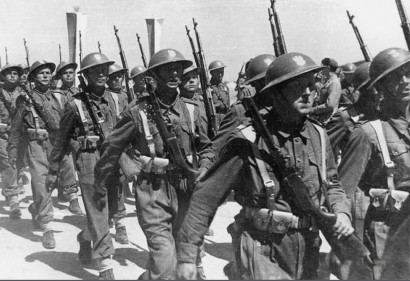Visitors are invited to the exhibition devoted to Anders’ Army, the history of its creation, and the fate of soldiers and civilians who walked the Trail of Hope. The exhibition will be held in the Open-Air Gallery near Aleje Ujazdowskie, from 14 August to 4 September 2017.
The exhibition presents the origins of the Anders’ Army, starting from the fate of Poles who came under Soviet occupation following the signing of the Ribbentrop-Molotov pact in 1939. Hundreds of thousands of them were sent to Gulags in Syberia and deep into the territories of the Soviet Union. Tens of thousands were killed, e.g. in Katyń in 1940. Others died in the so-called "white crematoriums" in the far north.
After the outbreak of the German-Soviet war in 1941, the Soviet Union joined the anti-fascist coalition. This allowed the Polish government in exile to sign, in London, the Sikorski-Mayski Agreement (30 July 1941), as a result of which, a Polish Army was to be formed in the territory of the Soviet Union. It was supposed to be led by Polish General, Władysław Anders, incarcerated by NKVD in Moscow at the time.
Thousands of Poles – both soldiers and civilians – came from across the Soviet Union to join the newly-formed Anders’ Army. For them, this was the only chance of rescue from an otherwise certain death in Soviet Gulags. Many died of exhaustion on their way to the army; others perished along the trail followed by the army – both in Central Asia (Kazakhstan, Uzbekistan, Turkmenistan, Tajikistan), Persia (Iran) and the Middle East (Iraq, Palestine).
The Anders’ Army allowed civilians – including thousands of children – to begin new lives in the free world, while soldiers were able to fight for a free Poland. Unfortunately, despite their devotion, they did not return to the fatherland, which – after the end of World War II in 1945 – came under Soviet occupation. For Poles in the Anders’ Army, it was the beginning of unsettled life in exile. Most of them settled in Great Britain, which – until 1989 – was the seat of the President and the Polish government in exile.
The rich photographic materials and factual descriptions displayed at the exhibition "Anders’ Army – The Trail of Hope" is the fruit of the work of numerous institutions of science and history and archives, including: Archive of New Records, Central Military Library, Polish Institute and Sikorski Museum in London, Polish Army Museum, National Digital Archives and the KARTA Center. The exhibition is organised under the patronage of the Prime Minister.
